What Type Of Thermal Animals Are Fish

Fish don't sweat to regulate their body temperature only they do have strategies for thermoregulation (www.fishlady.u.s.).
Thermoregulation is the process by which an organism controls its internal temperature. Fish accept many different mechanisms for regulating their temperature. Most fish are ectothermic, using their environmental temperature to manage their body temperature, just some fish are endothermic, having the metabolic ability to internally manage temperature. Poikilothermic fish are ectotherms which have no control over their torso temperature; their core body temperature conforms to ambient temperature. Eurythermic fish have evolved to survive in a wide range of environmental temperatures and stenothermic fish have evolved to survive in a narrow range of environmental temperatures.
Thermoregulation is very of import for fish because temperature influences the function of many organs and the rate of many metabolic processes. Most fish species accept evolved to survive within a specific temperature ranges; outside that range, enzymes can degrade, organs tin can fail, and the organism can die. Understanding thermoregulation for fish species is especially of import when considering implications for climatic change.
Poikilothermic fish have no command over their body temperature and their core body temperature tin can fluctuate broadly. While some ectothermic stenotherms thermoregulate their trunk temperature by inhabiting constant temperature environments, internal temperature of poikilotherms can widely vary.
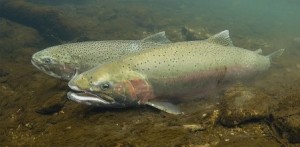
Thoughout their lives, Steelhead's internal temperature varies considerably (NPS).
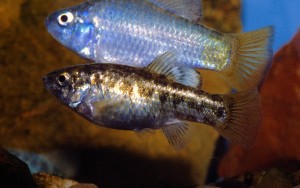
Desert Pupfish are eurythermic, surviving in temperatures ranging from part in waters from 4º to 45ºC (Paul V. Loiselle).
In dissimilarity to stenotherms, eurythermic fish can function at a wide range of water temperatures. They are often, but not necessarily, ectotherms. Desert Pupfish (Cyprinodon macularius), for example, tin function in ambient temperatures ranging from four to 45 degrees Celsius. This thermoregulatory strategy requires that organs, enzymes, and metabolic processes tin operate at varying ecology temperatures.
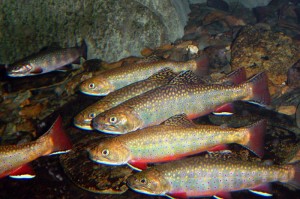
Beck Trout can only survive in a narrow band of temperatures (FWS).
In dissimilarity to eurytherms, senothermic fish can simply role in a narrow range of h2o temperatures. Beck Trout (Salvelinus fontinalis), for example, part optimally approximately between 13 and xviii degrees Celsius. This thermoregulatory strategy requires that organs, enzymes, and metabolic processes operate in a pocket-size temperature band and makes these fish especially vulnerable to environmental changes.

Ectothermic fish rely upon their environs to regulate their temperature (clipartOf.com).
Unlike endotherms which tin can metabolically control their ain trunk temperature, ectotherms rely upon environmental temperatures for thermoregulation. About fish are ectotherms. Ectothermy can be metabolically more efficient than endothermy because organisms do non take to expend whatever free energy to cocky-regulate their body temperatures. Withal, they are at the mercy of their environs more endotherms because they utilise ambient water temperature to control their body temperature.
Poikilothermic fish have no command over their torso temperature any. Their cadre trunk temperature conforms entirely to ambient temperature and can fluctuate widely. This means that their organs and enzymes need to be capable of performance at a range of temperatures. As physiological processes have often evolved to operate about efficiently at certain temperatures, ectothermic fish have evolved multiple strategies to maintain optimal thermal habitat. Stenotherms live within narrow ecology temperatures in contrast with eurytherms which can live in a wide range of environmental temperatures.
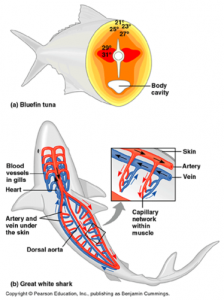
Though rare, some fish are able to internally regulate temperature.
Unlike ectotherms, which rely upon ecology temperatures, endotherms are able to metabolically control their trunk temperature. This thermoregulatory strategy is rare amid fish but is nowadays in tunas and some sharks, including the Great White Shark (Carcharodon carcharias) and Shortfin Mako Shark (Isurus oxyrinchus). Endothermic tunas and sharks use a network of capillaries in their swimming muscles, the Rete mirabile, every bit a heat exchanger. Through counter-current exchange, the heat produced through musculus activity is transported past the claret. Through this metabolic process, sharks, for example, can maintain a body temperature of 5 – 14°C in a higher place ambience water temperature. This process is an evolutionary reward for these long distance, migratory fish, allowing them to travel all-encompassing distances and swoop deep while maintaining body temperature, conserving energy, and fugitive thermal daze from changes in water temperature.
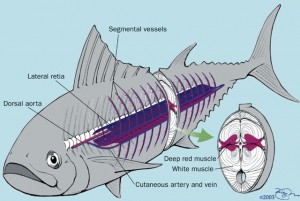
Tunas are 1 case of endothermic fish.
Source: https://fishionary.fisheries.org/tag/thermoregulation/
Posted by: broadwateruterming.blogspot.com

0 Response to "What Type Of Thermal Animals Are Fish"
Post a Comment